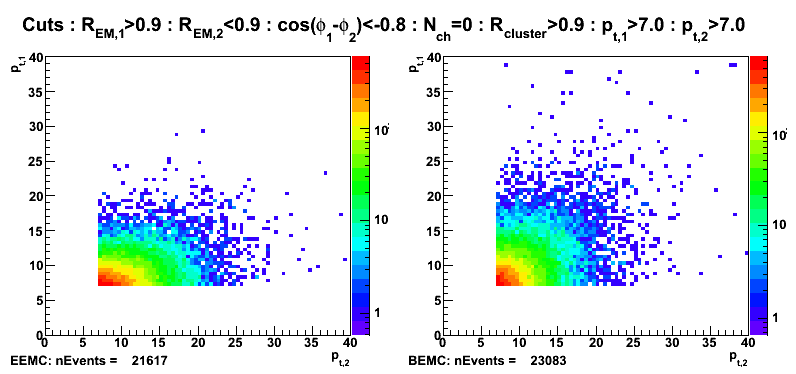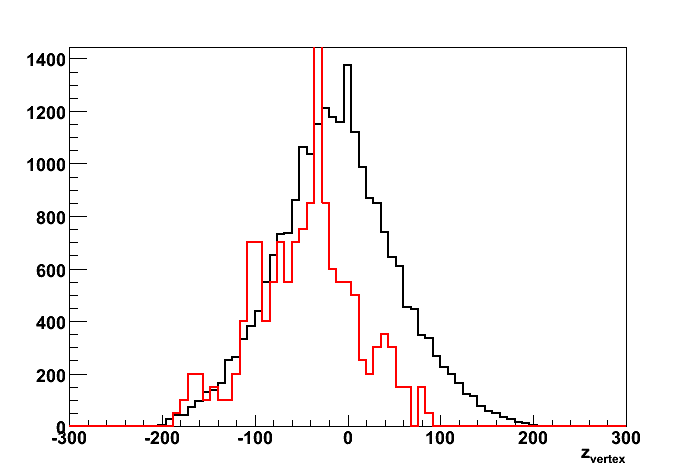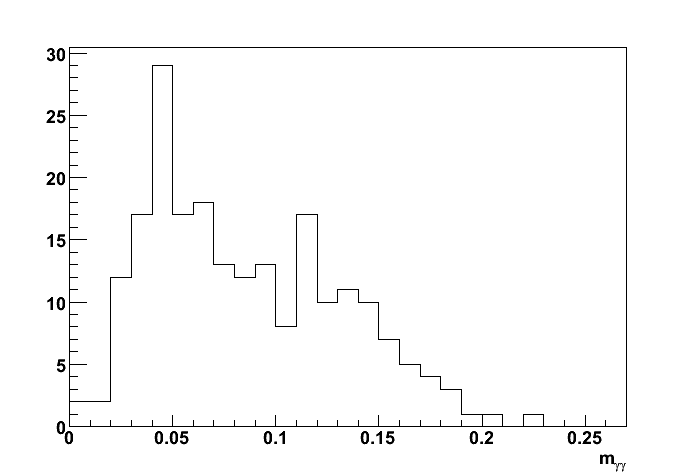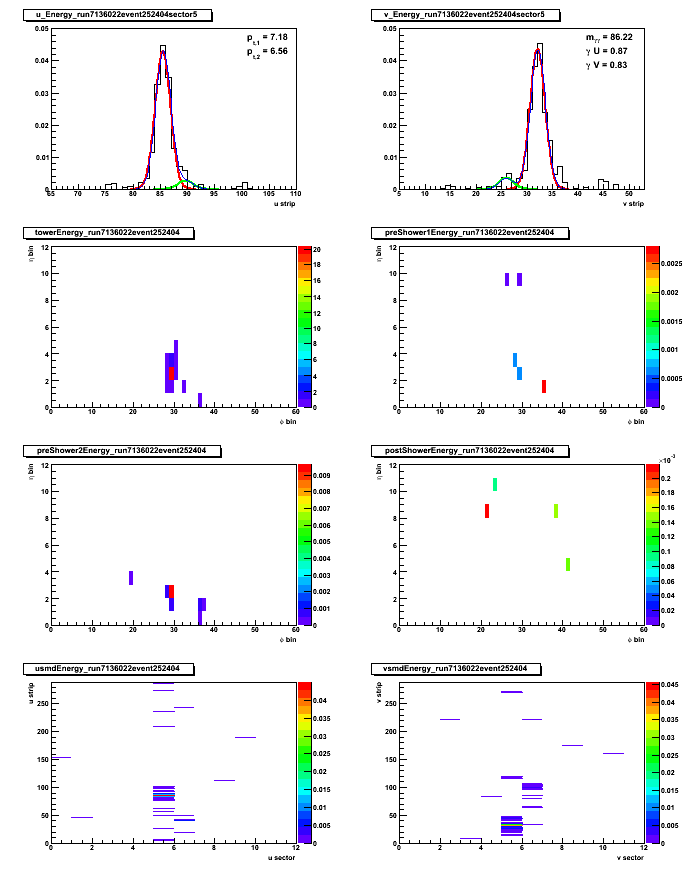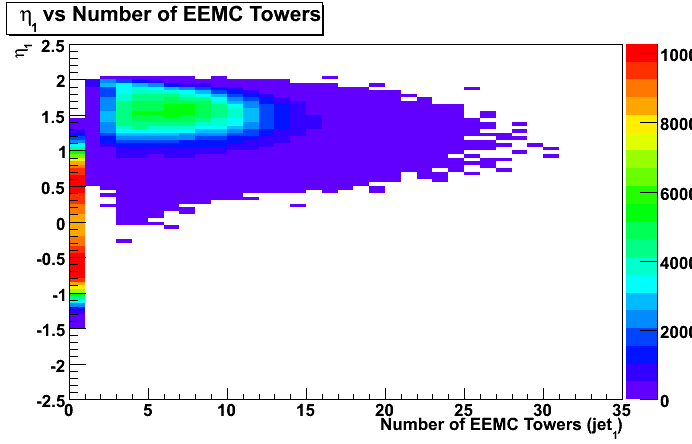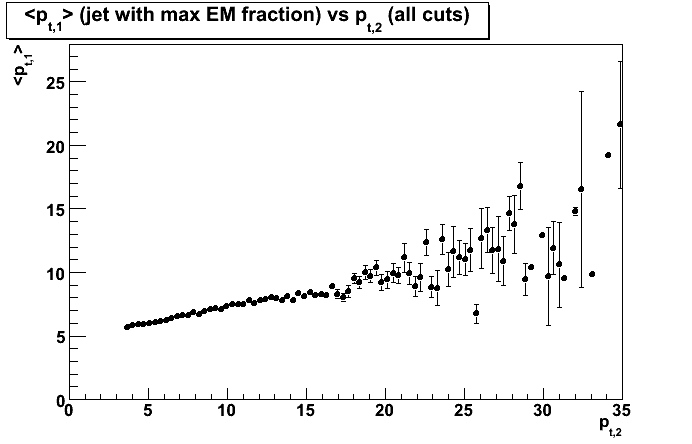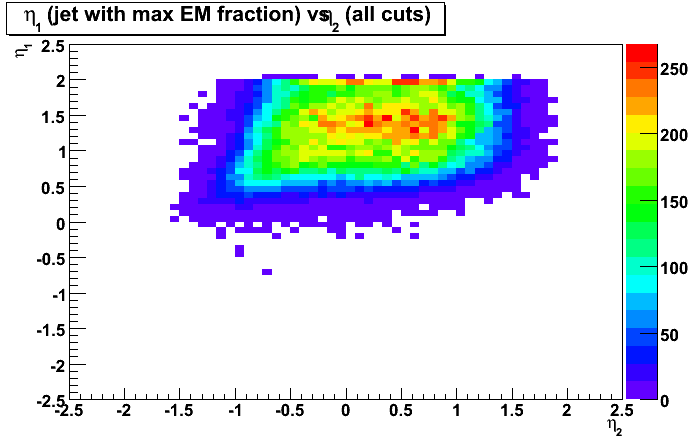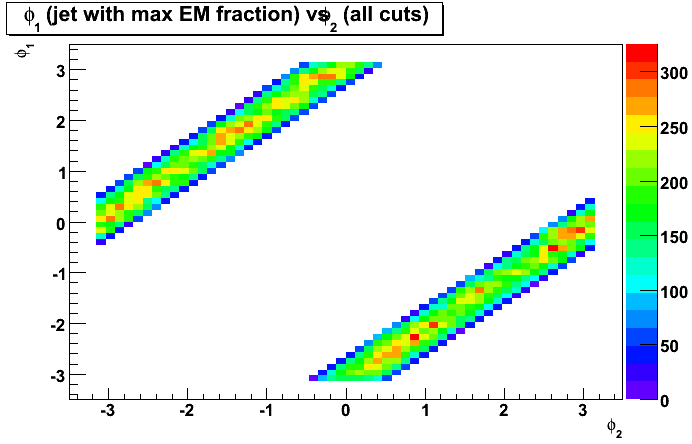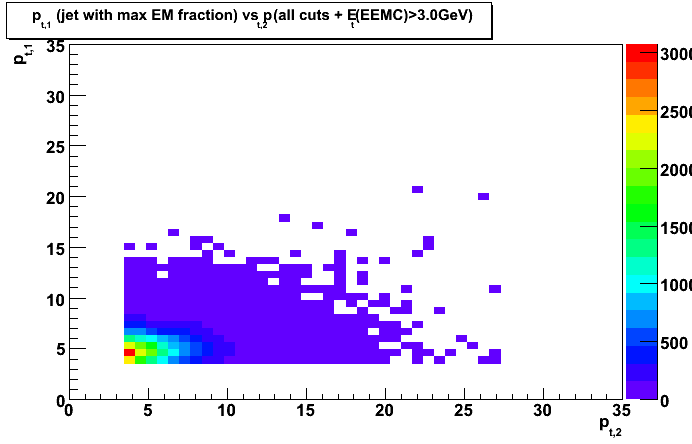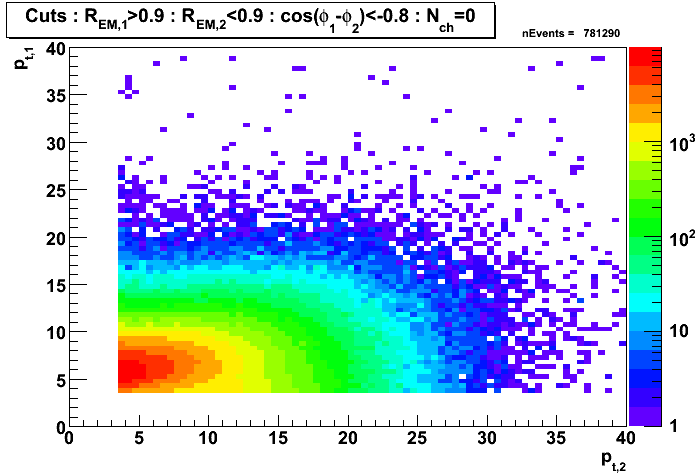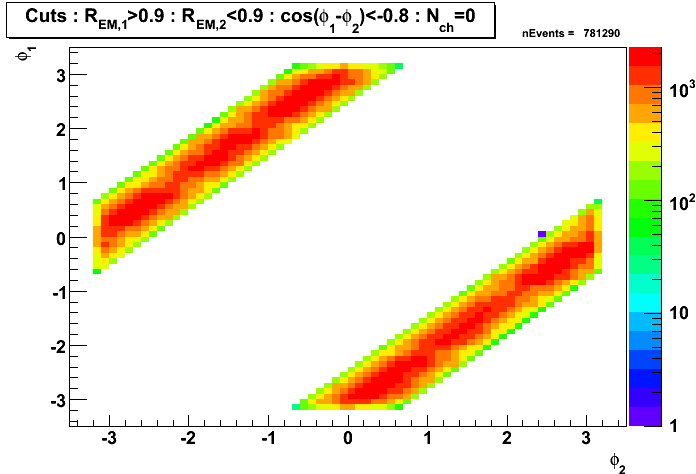02 Feb
February 2008 posts
2008.02.13 Gamma-jet candidates: EEMC response
Ilya Selyuzhenkov February 13, 2008
Data sample
Gamma-jet selection cuts are discussed here. There are 278 candidates found for runId=7136022.
Transverse momentum distribution for the gamma-jet candidates can be found here.
Vertex z distribution for di-jet and gamma-jet events
-
Figure 1: Vertex z distribution.
Red line presents gamma-jet candidates (scaled by x50). Black is for all di-jet events.
Same data on a log scale is here. - Figure 2: Average vertex z as a function of transverse momentum of the fist jet (with a largest EM energy fraction).
Red is for gamma-jet candidates. Black is for all di-jet events.
Strong deviation from zero for gamma-jet candidates at pt < 5GeV?
EEMC response for the gamma-jet candidate
EEMC response event by event for all 278 gamma-jet candidate can be found in this pdf file.
Each page shows SMD/Tower energy distribution for a given event:
-
First row on each page shows SMD response
for the sector which has a maximum energy deposited in the EEMC Tower
(u-plane is on the left, v-plane is on the right). -
In the left plot (u-plane energy distribution) numerical values for
pt of the first jet (with maximum EM fraction) and the second jet are given. -
In addition, fit results assuming gamma (single Gaussian, red line) or
neutral pion (double Gaussian, blue line ~ red+green) hypotheses are given. - m_{gamma gamma} value (it is shown in the right plot for v-plane).
If m_{gamma gamma} value is negative, then the reconstruction procedure has failed
(for example, no uv-strips intersection found, or tower energy and uv-strips intersection point mismatch, etc).
EEMC response for these "bad" events can be found in this pdf file.If reconstruction procedure succeded, then
m_{gamma gamma} gives reconstructed invariant mass assuming that two gammas hit the calorimeter.Figure 3: invariant mass distribution (assuming pi0 hypothesis).
Note, that I'm still working on my fitting algorithm (which is not explained here),
and fit results and the invariant mass distribution will be updated. -
It is also shown the ratio for each u/v plane
of the integrated single Gaussian fit (red line) to the total energy in the plane
(look for "gamma U/V " values on the right v-plane plot). -
Second and third rows on each page show the energy deposition in the
tower, pre-shower1, pre-shower2, and post-shower as a function of eta:phi (etaBin:phiBin). - Last row shows the hit distribution in the SMD for all sectors
(u-plane on the left, v-plane of the right).
Playing with a different cuts
Trying to isolate the real gammas which hits the calorimeter,
I have sorted events into different subsets based on the following set of cuts:
- EEMC gamma-jet cuts (energetic photon hits EEMC with pt similar or greater to that of the opposite jet)
if (invMass < 0) reject
if (jet2_pt > jet1_pt) reject
if (jet1_pt < 7) reject
if (minFraction < 0.75) reject
(minFraction = gamma U/V - is a fraction of the integrated single Gaussian peak to the total energy in the uv-plane)Figure 4: Sample gamma-jet candidate EEMC response
(all gamma-jet candidates selected according to these conditions can be found in this pdf file): - EEMC pi0 cuts:
if (invMass < 0) reject
if (jet2_pt < jet1_pt) reject
if (jet2_pt < 7) reject
if (minFraction < 0.75) rejectEvent by event EEMC response for pi0 (di-jet) candidates
selected according to these conditions can be found in this pdf file.
2008.02.20 Gamma-jet candidates: more statistics from jet-trees
Ilya Selyuzhenkov February 20, 2008
Short summary
After processing all available jet-trees for pp2006 (ppProductionLong),
and applying all "gamma-jet" cuts (which are described below):
-
there are 47K di-jet events selected
-
for pt1>7GeV there are 5,4K gamma-jet candidates (3,7K with an additional cut of pt1>pt2)
-
Figure 1: 2,4K events with both pt1, pt2 > 7GeV
-
721 candidates within a range of pt1>pt2 and both pt1, pt2 > 7 GeV
Data set
jet trees by Murad Sarsour for pp2006 run, number of runs processed: 323
4.7M di-jet events found (no triggerId cuts yet)
Di-jets gross features
- Figure 2: Distribution of electromagnetic energy (EM) fraction, R_EM, for di-jet events (number of jets/event = 2).
R_EM = [E_t(endcap)+E_t(barrel)]/E_t(total).
Black histogram is for R_EM1 = max(Ra, Rb), red is for R_EM2 = min(Ra, Rb).
Ra and Rb are EM fraction for jets in the di-jet event.
Same data on a log scale is here.
Gamma-jet isolation cuts:
- selecting di-jet events with one of the jet dominated by EM energy,
and another one with more hadronic energy:R_EM1 >0.9 and R_EM2 < 0.9
- selecting di-jet events with jets pointing opposite in azimuth:
cos(phi1 - phi2) < -0.9
- requiring the number of associated charged tracks with a first jet (with maximum EM fraction) to be less than 2:
nChargeTracks1 < 2
- requiring the number of fired EEMC towers associated with a first jet (with maximum EM fraction) to be 1 or 2:
0 < nEEMCtowers1 < 3
Applying gamma-jet isolation cuts
- Figure 3: Distribution of eta vs number of EEMC towers for the first jet (with maximum EM fraction).
Cuts:1-3 applied (no 0 < nEEMCtowers1 < 3 cut). - Figure 4: Distribution of transverse momentum, pt1, of the first jet (with maximum EM fraction)
vs transverse momentum, pt2, of the second jet.
Cuts:1-4 applied - Figure 5: Distribution of mean transverse momentum, < pt1 >, of the first jet (with maximum EM fraction)
vs transverse momentum, pt2, of the second jet.
Cuts:1-4 applied - Figure 6: Distribution of pseudorapidity, eta1, of the first jet (with maximum EM fraction)
vs pseudorapidity, eta2, of the second jet.
Cuts:1-4 applied - Figure 7: Distribution of azimuthal angle, phi1, of the first jet (with maximum EM fraction)
vs azimuthal angle, phi2, of the second jet.
Cuts:1-4 applied - Figure 8: Distribution of transverse momentum, pt1, of the first jet (with maximum EM fraction)
vs transverse energy sum for the EEMC towers associated with this jet.
Cuts:1-4 applied - Figure 9: Distribution of transverse momentum, pt1, of the first jet (with maximum EM fraction)
vs transverse momentum, pt2, of the second jet.
Cuts:1-4 + Et(EEMC) > 3.0 GeV
2008.02.27 Tower based clustering algorithm, and EEMC/BEMC candidates
Ilya Selyuzhenkov February 27, 2008
Gamma-jet candidates before applying clustering algorithm
Gamma-jet isolation cuts:
- selecting di-jet events with the first jet dominated by EM energy,
and the second one with a large fraction of hadronic energy:R_EM1 >0.9 and R_EM2 < 0.9
- selecting di-jet events with jets pointing opposite in azimuth:
cos(phi1 - phi2) < -0.8
- requiring no charge tracks associated with a first jet (jet with a maximum EM fraction):
nCharge1 = 0
Tower based clustering algorithm
-
for each gamma-jet candidate finding a tower with a maximum energy
associated with a jet1 (jet with a maximum EM fraction). -
Calculating energy of the cluster by finding all adjacent towers and adding their energy together.
- Implementing a cut based on cluster energy fraction, R_cluster, where
R_cluster is defined as a ratio of the cluster energy
to the total energy in the calorimeter associated with a jet1.
Note, that with a cut Ncharge1 =0, energy in the calorimeter is equal to the jet energy.
Distribution of cluster energy vs number of towers fired in EEMC/BEMC
Figure 4: R_cluster vs number of towers fired in EEMC (left) and BEMC (right). No pt cuts.
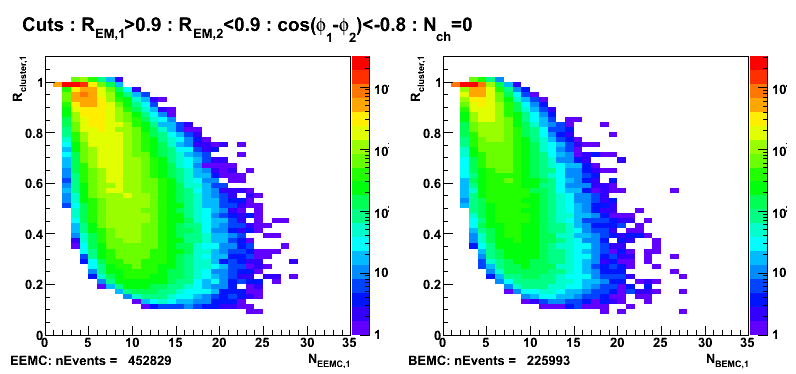
Figure 5: R_cluster vs number of towers fired in EEMC (left) and BEMC (right). Additional cut: pt1>7GeV
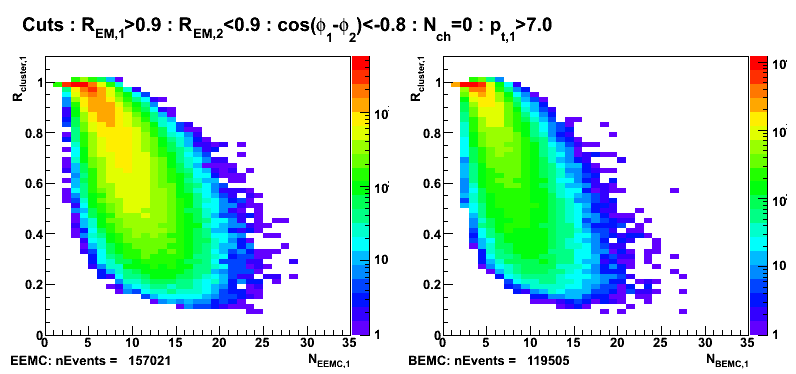
Figure 6: jet1 pseudorapidity vs number of towers fired in EEMC (left) and BEMC (right).
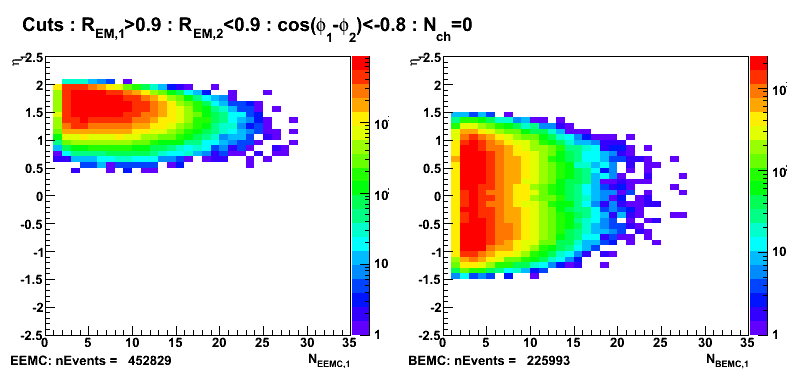
R_cluster>0.9 cut: EEMC vs BEMC gamma-jet candidates
EEMC candidates: nTowerFiredBEMC=0
BEMC candidates: nTowerFiredEEMC=0
Figure 7: Pseudorapidity (left EEMC, right BEMC candidates)
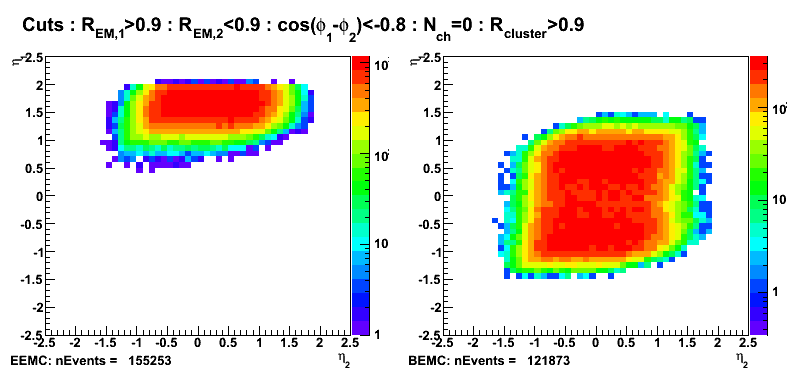
Figure 8: Azimuthal angle (left EEMC, right BEMC candidates)
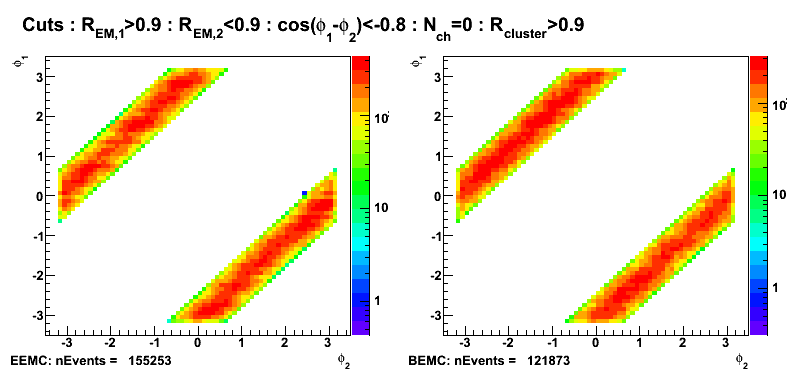
Figure 9: Transverse momentum (left EEMC, right BEMC candidates)
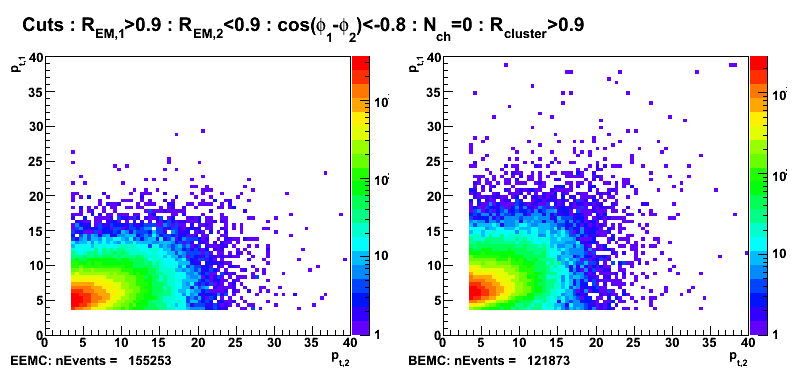
Number of gamma-jet candidates with an addition pt cuts
Figure 10: Transverse momentum (left EEMC, right BEMC candidates): pt1>7GeV

Figure 11: Transverse momentum (left EEMC, right BEMC candidates): pt1>7 and pt2>7
